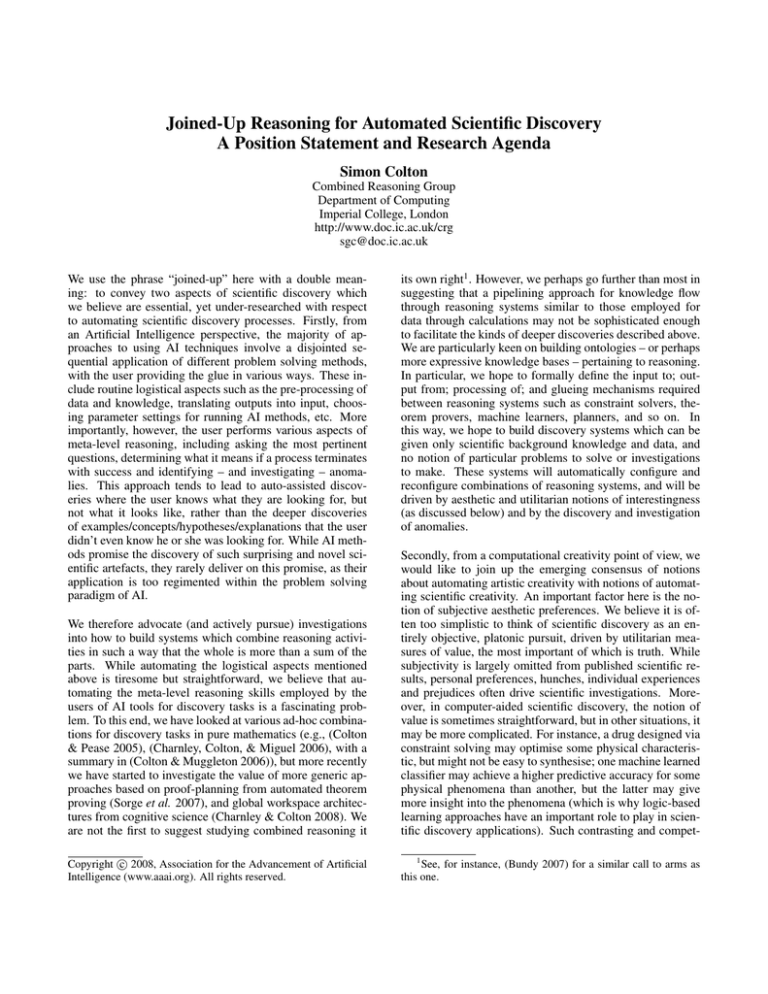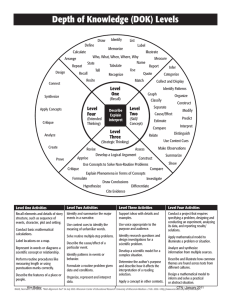
Joined-Up Reasoning for Automated Scientific Discovery
A Position Statement and Research Agenda
Simon Colton
Combined Reasoning Group
Department of Computing
Imperial College, London
http://www.doc.ic.ac.uk/crg
sgc@doc.ic.ac.uk
We use the phrase “joined-up” here with a double meaning: to convey two aspects of scientific discovery which
we believe are essential, yet under-researched with respect
to automating scientific discovery processes. Firstly, from
an Artificial Intelligence perspective, the majority of approaches to using AI techniques involve a disjointed sequential application of different problem solving methods,
with the user providing the glue in various ways. These include routine logistical aspects such as the pre-processing of
data and knowledge, translating outputs into input, choosing parameter settings for running AI methods, etc. More
importantly, however, the user performs various aspects of
meta-level reasoning, including asking the most pertinent
questions, determining what it means if a process terminates
with success and identifying – and investigating – anomalies. This approach tends to lead to auto-assisted discoveries where the user knows what they are looking for, but
not what it looks like, rather than the deeper discoveries
of examples/concepts/hypotheses/explanations that the user
didn’t even know he or she was looking for. While AI methods promise the discovery of such surprising and novel scientific artefacts, they rarely deliver on this promise, as their
application is too regimented within the problem solving
paradigm of AI.
its own right1 . However, we perhaps go further than most in
suggesting that a pipelining approach for knowledge flow
through reasoning systems similar to those employed for
data through calculations may not be sophisticated enough
to facilitate the kinds of deeper discoveries described above.
We are particularly keen on building ontologies – or perhaps
more expressive knowledge bases – pertaining to reasoning.
In particular, we hope to formally define the input to; output from; processing of; and glueing mechanisms required
between reasoning systems such as constraint solvers, theorem provers, machine learners, planners, and so on. In
this way, we hope to build discovery systems which can be
given only scientific background knowledge and data, and
no notion of particular problems to solve or investigations
to make. These systems will automatically configure and
reconfigure combinations of reasoning systems, and will be
driven by aesthetic and utilitarian notions of interestingness
(as discussed below) and by the discovery and investigation
of anomalies.
We therefore advocate (and actively pursue) investigations
into how to build systems which combine reasoning activities in such a way that the whole is more than a sum of the
parts. While automating the logistical aspects mentioned
above is tiresome but straightforward, we believe that automating the meta-level reasoning skills employed by the
users of AI tools for discovery tasks is a fascinating problem. To this end, we have looked at various ad-hoc combinations for discovery tasks in pure mathematics (e.g., (Colton
& Pease 2005), (Charnley, Colton, & Miguel 2006), with a
summary in (Colton & Muggleton 2006)), but more recently
we have started to investigate the value of more generic approaches based on proof-planning from automated theorem
proving (Sorge et al. 2007), and global workspace architectures from cognitive science (Charnley & Colton 2008). We
are not the first to suggest studying combined reasoning it
Secondly, from a computational creativity point of view, we
would like to join up the emerging consensus of notions
about automating artistic creativity with notions of automating scientific creativity. An important factor here is the notion of subjective aesthetic preferences. We believe it is often too simplistic to think of scientific discovery as an entirely objective, platonic pursuit, driven by utilitarian measures of value, the most important of which is truth. While
subjectivity is largely omitted from published scientific results, personal preferences, hunches, individual experiences
and prejudices often drive scientific investigations. Moreover, in computer-aided scientific discovery, the notion of
value is sometimes straightforward, but in other situations, it
may be more complicated. For instance, a drug designed via
constraint solving may optimise some physical characteristic, but might not be easy to synthesise; one machine learned
classifier may achieve a higher predictive accuracy for some
physical phenomena than another, but the latter may give
more insight into the phenomena (which is why logic-based
learning approaches have an important role to play in scientific discovery applications). Such contrasting and compet-
c 2008, Association for the Advancement of Artificial
Copyright Intelligence (www.aaai.org). All rights reserved.
1
See, for instance, (Bundy 2007) for a similar call to arms as
this one.
ing assessment criteria are commonplace in studies of computational creativity in the arts, which has led to the determination of concrete value measures based on the artefacts
produced by creative systems, in particular, Ritchie’s criteria, described in (Ritchie 2007).
We therefore advocate (and actively pursue) investigations
into modelling individual or group aesthetics which can be
used to drive scientific exploration. Such aesthetics may alter during the course of an investigation, they may be inconsistent, and pinpointing the notion of value in a particular
domain may itself represent a discovery. We believe that,
for computational approaches to gain more autonomy and
higher potential for finding the kinds of deeper discoveries
described above, software has to be taught not only some
received principals about interest and value, but also has to
be taught how to invent – and defend – its own heuristics
for the value of scientific artefacts. While there is a glut
of data in most sciences (although many argue that getting
the right kind of data is still the most important and difficult
aspect of a scientific investigation), and a growing number
of scientific knowledge bases, there is very little heuristic
information available about what a researcher might find interesting or anomalous. In the application domain of graphic
design, we have begun investigations both into how software
can learn someone’s aesthetic preferences from their actions
and choices (Colton 2008c), and how software can invent
its own fitness function (Colton 2008a) in order to appear to
be more creative.2 We hope to show that such learning and
invention of notions of interestingness can also be fruitfully
applied in scientific discovery applications.
In summary, our position is that it is time for researchers to
investigate software which controls other, third party, scientific discovery software, and our research agenda is to
build generic mechanisms for the combination of reasoning
systems which can undertake large-scale, multi-faceted investigations autonomously, driven by complex and evolving
models of value in scientific artefacts. Joining up reasoning
systems in practice and joining up our understanding of creative activity across the arts and sciences, will – we hope –
lead to greatly improved automation in scientific discovery
systems.
Acknowledgements
We would like to thank the organisers of the AAAI Fall symposium on Automated Scientific Discovery for the opportunity to present this position statement and research agenda.
We would also like to thank the numerous colleagues who
have collaborated with us to conceive, construct and experiment with combined reasoning systems for scientific and
artistic creative purposes.
2
See (Colton 2008b) for a discussion of the perception of creativity in computational systems.
References
Bundy, A. 2007. Cooperating reasoning processes: More
than just the sum of their parts. In Veloso, M., ed., Proceedings of the 20th International Joint Conference on Artificial
Intelligence, 2007, 2–11.
Charnley, J., and Colton, S. 2008. A global workspace
framework for combining reasoning systems. In Proceedings of the CICM workshop on Empirically Successful Automated Reasoning Systems for Mathematics.
Charnley, J.; Colton, S.; and Miguel, I. 2006. Automatic
generation of implied constraints. In Proceedings of the
17th European Conference on AI.
Colton, S., and Muggleton, S. 2006. Mathematical applications of Inductive Logic Programming. Machine Learning
64:25–64.
Colton, S., and Pease, A. 2005. The TM system for
repairing non-theorems. In Selected papers from the IJCAR’04 disproving workshop, Electronic Notes in Theoretical Computer Science, volume 125(3). Elsevier.
Colton, S. 2008a. Automatic invention of fitness functions,
with application to scene generation. In Proceedings of the
EvoMusArt Workshop.
Colton, S. 2008b. Creativity versus the perception of creativity in computational systems. In Proceedings of the
AAAI Spring Symposium on Creative Systems.
Colton, S. 2008c. Experiments in constraint-based automated scene generation. In Proceedings of the 5th International Joint Workshop on Computational Creativity.
Ritchie, G. 2007. Some empirical criteria for attributing
creativity to a computer program. Minds and Machines
17:67–99.
Sorge, V.; Meier, A.; McCasland, R.; and Colton, S. 2007.
Automatic construction and verification of isotopy invariants. Journal of Automated Reasoning 40(2-3):221–243.






